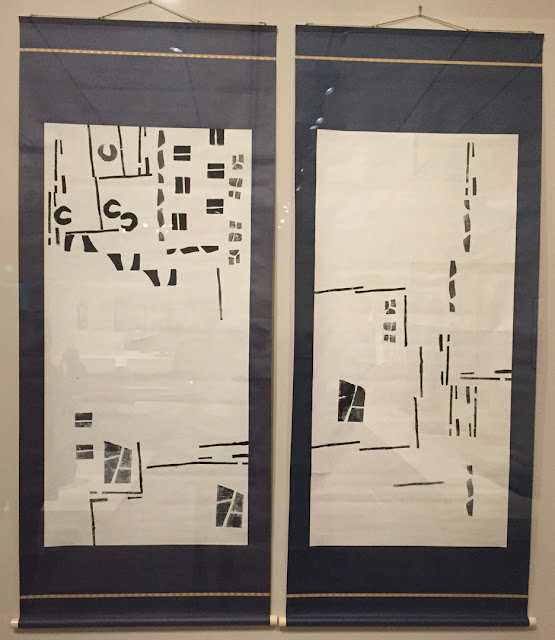A friend and I had been talking about this show for weeks, and we happily got to see the exhibition, Changing and Unchanging Things: Noguchi and Hasegawa in Postwar Japan three days before it closed. Isamu Noguchi and Saburo Hasegawa were friends; they met in 1950, and their shared interests, both in Japanese traditions and in pushing art in the modern world led them to numerous conversations. The exhibition continues the conversation by intermingling their works, placed sensitively over two gallery spaces. Part of their practices look at the blending of natural and humanmade concepts and forms. Textures, lines, and marks are distinctive in both. I immediately wanted to rush home and make something; seeing the work to me was like eating something delicious.
I particularly noticed the balance and contrasts between thick and thin brushstrokes, strong and delicate lines and materials, soft and hard, smooth and rough, organic and architectural, printed and painted, as well as the range of grays to black ink. Here are a few works I found particularly inspiring, each to me like a beautifully played chord.
I particularly noticed the balance and contrasts between thick and thin brushstrokes, strong and delicate lines and materials, soft and hard, smooth and rough, organic and architectural, printed and painted, as well as the range of grays to black ink. Here are a few works I found particularly inspiring, each to me like a beautifully played chord.
Noguchi
"Yoshiko-san"
1952
iron and rope
Yoshiko was the artist's wife. The wall text suggested this was like her hair, but the organic shapes to me are more alive than hair.
Noguchi
"Face Dish"
1952
Shigaraki stoneware
Hasegawa
"Mountain and Water, Forming a Landscape"
1954
lithograph and ink on paper
Noguchi
The Curtain of Dream
1952
Shigaraki stoneware
Hasegawa
"I-Ro-Ha (The Japanese Syllabary)"
1954
lithograph and ink on paper
Hasagawa
"Time"
1952
wood rubbing and ink on paper
Hasagawa
"Self-Portrait"
1951
ink on paper
Hasegawa
"Nude"
approximately 1951
ink on paper
So spare and abstract, yet we can read the image.
Hasegawa
"Portrait of Laozi"
1954
ink on paper
The wall text translation of the poem tells us this is about someone who feels different from others.
detail from above work, "Portrait of Laozi"
Hasegawa
"Untitled"
1951
ink on paper
Printed from wood scraps.
back of two Noguchi sculptures, three lithographs by Hasegawa
Noguchi
"Mortality"
1959
balsa
Hasegawa
"From Laozi"
1954
ink on paper
&
Noguchi
"The Footstep"
1958
Mannari, granite, and pine
A particularly pleasing pairing.
Hasegawa
"From Laozi"
1954
ink on paper
Hasegawa
"Great Chorus"
1957
ink on paper
Of all the printing from wood pieces, I think this one comes together the best: detailed composition, contrasts, balanced composition and colors. I was particularly interested in how a particular wood shape could be rotated and look like a completely new shape. The publisher of the exhibition catalogue used this piece as the patterned cover.
Hasegawa
"Untitled"
1952
wood rubbing and ink on paper
I was interested how this was made, how you could overlap shapes like a collage. You can see which shapes were likely printed first.
Hasegawa's printing block
Seeing the block feels intimate; you know he touched it, and then you can see how he printed it in the piece, below.
Hasegawa
"Profundity (Yugen)"
1952
wood rubbing and ink on paper
Noguchi
"Sesshu"
1958
Anodized aluminum
I noticed this reminded me of cut and folded paper, kirigami, which the wall text also mentions. The piece was created in memory of Hasegawa, who had died of cancer the year earlier. Hasagawa was an admirer of Sesshu's ink painting, particularly the grays.
Noguchi
"Large Square"
1952
Karatsu stoneware
Hasegawa
"From Laozi"
1952
ink on paper
The wall text translation suggests this is a poem about simplicity and contentment. There are two little representations on the painting: a dog and a chicken.
detail of above work, "From Laozi." buck, buck, buck. ( ' )>
Noguchi
"Large Walking Box"
1952
Karatsu stoneware on wood dowels
The title suggests that this is a being. What else walks? Perfectly shaped, with slashes and irregular cuts in it.
Noguchi
"Not Musicians"
1958
aluminum and paint
This piece is nicely lit, casting shadows as artful as the piece.
Noguchi
"Akari lanterns"
1952
paper, bamboo, and metal
Anyone remember the Noguchi postage stamps from 2004?



























Comments